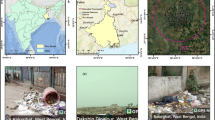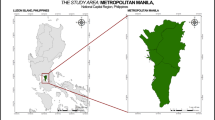Abstract
This paper focuses on land resource consumption due to urban sprawl. Special attention is given to shrinking regions, characterized by economic decline, demographic change, and high unemployment rates. In these regions, vast terrain is abandoned and falls derelict. A geographic information system (GIS) based multi-criteria decision tool is introduced to determine the reuse potential of derelict terrain, to investigate the possible reuse options (housing, business and trade, industry, services, tourism and leisure, and re-greening), and to visualize the best reuse options for groups of sites on a regional scale. Achievement functions for attribute data are presented to assess the best reuse options based on a multi-attribute technique. The assessment tool developed is applied to a model region in Germany. The application of the assessment tool enables communities to become aware of their resources of derelict land and their reuse potential.
Similar content being viewed by others
References
EPA. International Brownfields Case Study: Emscher Park, Germany, [Online], Avaiable: http://www.epa.gov/brownfields/partners/emscher.html, 2007.
D. D. Genske. Urban Land: Degradation, Investigation, Remediation, Berlin, Germany: Springer, 2003.
D. D. Genske. Investigation, Remediation and Protection of Land Resources, Dunbeath, UK: Whittles, 2007.
EEA. Land Accounts for Europe 1990–2000: Towards Integrated Land and Ecosystem Accounting, Copenhagen, Danmark: European Environment Agency, 2006.
B. Mohaupt-Jahr, M. Keil, R. Kiefl. CORINE Land Cover 2000 in Germany and Europe and Its Use for Environmental Applications, Berlin, Germany: UBA, 2004.
EEA. Urban Sprawl in Europe: The Ignored Challenge, EEA Report No. 10/2006, European Environmental Agency, Copenhagen, Danmark, 2006.
V. Schrenk. Preliminary Study on the Recycling of Industrial Terrain, Land Management and Groundwater Protection, Stuttgart, Germany: Institut für Wasserbau VEGAS Universität Stuttgart, 2000. (in German)
A. Valda, R. Westermann. Derelict Switzerland: Development Chances in Agglomerations, Bern, Switzerland: BUWAL, 2004. (in German)
P. Oswalt. Shrinking Cities: International Case Files, Ostfildern, Germany: Hatje Cantz, 2005.
P. Oswalt. Shrinking Cities: Actions, Ostfildern, Germany: Hatje Cantz, 2005.
P. Oswalt, T. Rieniets. Atlas of Shrinking Cities, Ostfildern, Germany: Hatje Cantz, 2006.
P. Doetsch, A. Ruepke. Brownfield Remediation versus Greenfield Consumption, Dessau, Germany: Umweltbundesamt UBA, 1998. (in German)
P. A. Longley, M. F. Goodchild, D. J. Maguire, D. W. Rhind. Geographical Information Systems and Science, 2nd ed., Chichester, UK: Wiley, 2005.
J. Malczewski. GIS-based land-use suitability analysis: A critical overview. Progress in Planning, vol. 62, no. 1, pp. 3–65, 2004.
M. G. Collins, F. R. Steiner, M. J. Rushman. Land-use suitability analysis in the United States: Historical development and promising technological achievements. Environmental Management, vol. 28, no. 5, pp. 611–621, 2001.
Q. Shen, R. Jensen. Rough sets, their extensions and applications. International Journal of Automation and Computing, vol. 4, no. 3, pp. 217–228, 2007.
Y. Q. Wang, D. H. Zhou, L. H. Liu. Reliable memory feedback design for a class of nonlinear fuzzy systems with time-varying delay. International Journal of Automation and Computing, vol. 4, no. 2, pp. 169–176, 2007.
J. R. Eastman. IDRISI for Windows, Version 2.0: Tutorial Exercises, Worcester, USA: Clark University, Graduate School of Geography, 1997.
R. Jansen, P. Rietveld. Multi-criteria analysis and geographical information systems: An application to agricultural land use in the Netherlands. Geographical Information Systems for Urban and Regional Planning, H. J. Scholten, J. C. H. Stillwell, Eds., Dordrecht, Holland: Kluwer Academic Publisher, 1990.
J. Malczewski. GIS and Multicriteria Decision Analysis, New York, USA: Wiley, 1999.
D. D. Genske, A. Ruff. Land recycling in shrinking regions: Background, strategies and examples. Bodenschutz, vol. 12, no. 1, pp. 8–14, 2007. (in German)
H. Jiang, J. R. Eastman. Application of fuzzy measures in multi-criteria evaluation in GIS. International Journal of Geographical Information Science, vol. 14, no. 2, pp. 173–184, 2000.
J. Malczewski. GIS-based multicriteria decision analysis: A survey of the literature. International Journal of Geographical Information Science, vol. 20, no. 7, pp. 703–726, 2006.
R. R. Yager. On ordered weighted averaging aggregation operators in multi-criteria decision making. IEEE Transactions on Systems, Man, and Cybernetics, vol. 18, no. 1, pp. 183–190, 1988.
T. J. Ross. Fuzzy Logic with Engineering Applications, 2nd ed., Chichester, UK: Wiley, 2004.
M. Hanss. Applied Fuzzy Arithmetic: An Introduction with Engineering Applications, Berlin, Heidelberg, Germany: Springer, 2005.
R. Banai. Fuzziness in geographic information systems: Contributions from the analytic hierarchy process. International Journal of Geographical Information Systems, vol. 7, no. 4, pp. 315–329, 1993.
P. A. Burrough, R. A. McDonnell. Principles of Geographical Information Systems, Oxford, USA: Oxford University Press, 1998.
G. B. Hall, F. Wang, Subaryono. Comparison of Boolean and fuzzy classification methods in land suitability analysis by using geographical information systems. Environment and Planning A, vol. 24, no. 4, pp. 497–516, 1992.
J. Malczewski. Ordered weighted averaging with fuzzy quantifiers: GIS-based multicriteria evaluation for land-use suitability analysis. International Journal of Applied Earth Observation and Geoinformation, vol. 8, no. 4, pp. 270–277, 2006.
Author information
Authors and Affiliations
Corresponding author
Additional information
This work was supported by the German Federal Ministry of Education and Research (BMBF Berlin), the Federal Office of Building and Regional Planning (BBR Bonn), the State of Thuringia and the State Development Corporation (LEG) Thuringia.
Dieter D. Genske studied civil engineering and geology at Wuppertal University and Technische Hochschule Aachen, Germany, and University of Kansas, USA, and received the master degrees in both disciplines. After he received the Ph.D. degree at Wuppertal University, Germany, he started working on engineering and environmental problems, first as Humboldt Research Fellow in Kyoto, Japan, then as project manager at Deutsche Montan Technologie (DMT), Germany. He taught at a number of universities including the TU Delft, Holand, Holand, the Ecole Polytechnique Fédérale de Lausanne (EPFL), Switzerland, and ETH Zurich, Switzerland. He was the head of Anthroposphere Dynamics Research Group at the Institute of Environmental Decisions, ETH Zurich, Switzerland. He is currently a professor of Institute of Architecture and Planning, University of Liechtenstein, Liechtenstein.
His research interests include sustainable development and land management.
Dongbin Huang received the Ph.D. degree based on his work on policy analysis and computation method in environmental decisions research from ETH Zurich, Switzerland. He is at present a senior scientist and lecturer at the Anthroposphere Dynamics Research Group at Institute of Environmental Decisions, ETH Zurich, engaging in research and teaching in decision engineering, and environmental studies.
His research interests include environmental decision analysis, collabrative action problems, negotiation analysis, and policy simulations.
Ariane Ruff received the M. Sc. degree in geography at the University of Potsdam, Germany. She has been involved in a number of research projects dealing with land management and land recycling. She is currently a research assistant at Fachhochschule Nordhausen, Germany.
Her research interests include sustainable land management and geographic information system (GIS).
Rights and permissions
About this article
Cite this article
Genske, D.D., Huang, D. & Ruff, A. An assessment tool for land reuse with artificial intelligence method. Int. J. Autom. Comput. 7, 1–8 (2010). https://doi.org/10.1007/s11633-010-0001-2
Received:
Revised:
Published:
Issue Date:
DOI: https://doi.org/10.1007/s11633-010-0001-2




